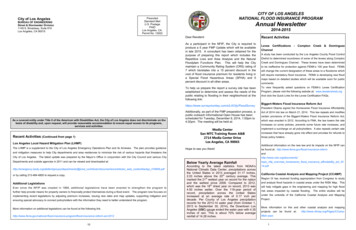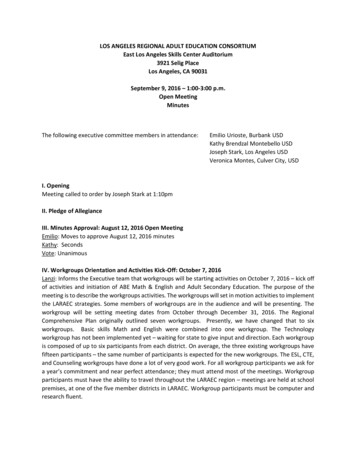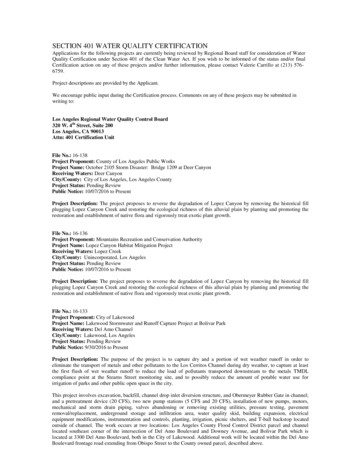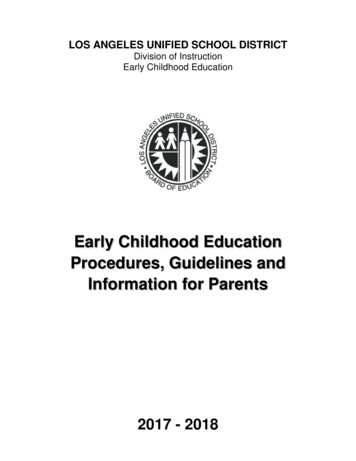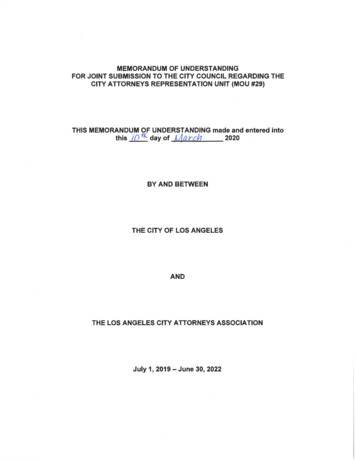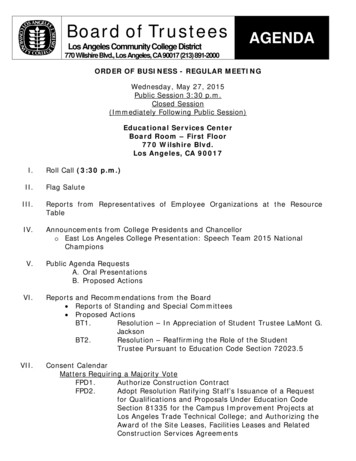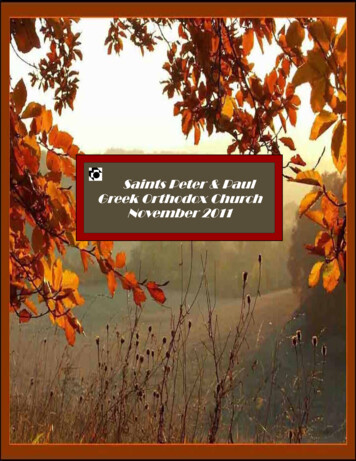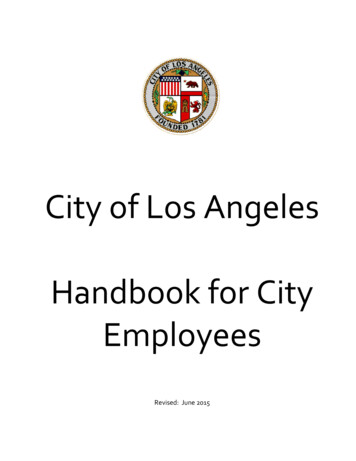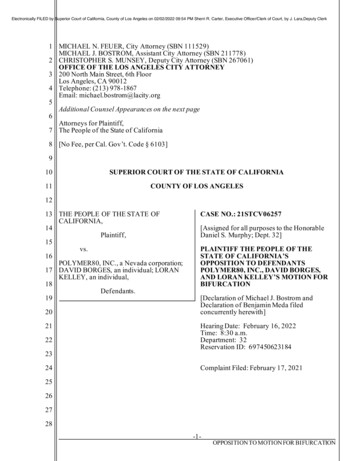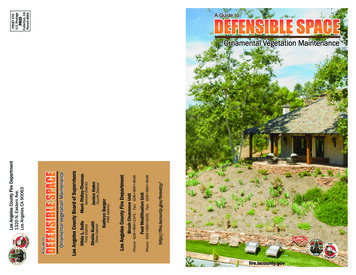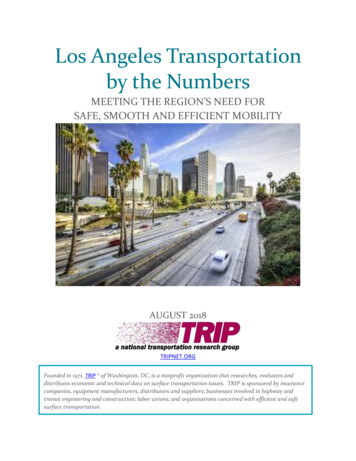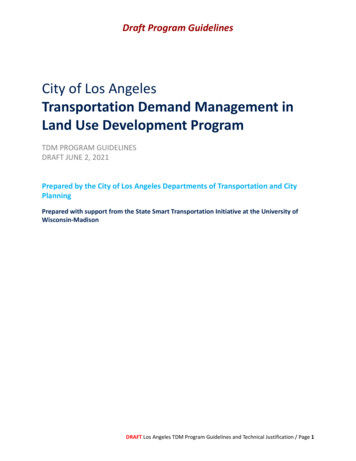
Transcription
Draft Program GuidelinesCity of Los AngelesTransportation Demand Management inLand Use Development ProgramTDM PROGRAM GUIDELINESDRAFT JUNE 2, 2021Prepared by the City of Los Angeles Departments of Transportation and CityPlanningPrepared with support from the State Smart Transportation Initiative at the University ofWisconsin-MadisonDRAFT Los Angeles TDM Program Guidelines and Technical Justification / Page 1
Draft Program GuidelinesContentsExecutive Summary4Preface5Overview6Chapter 1: Introduction1.1 Development of Transportation Demand Management (TDM) Program771.2 Transportation Demand Management in Los Angeles1.2.1 Alignment with Mobility Plan 20351.3 Transportation Demand Management and California Policy1.4 Outreach88910Chapter 2: Program Goals and Benefits2.1 Program Goals11112.1.1 Transportation System Efficiency112.1.2 Environmental and Public Health Outcomes112.1.3 Equity112.1.4 Transportation Happiness112.1.5 Context Sensitive Approach112.1.6 Adaptive122.1.7 Streamlined Project Review and Monitoring122.1.8 Effective Program Evaluation12Chapter 3: Applicability, Levels, and Point Targets3.1 Applicability13133.1.1 Land Use Categories133.1.2 Exemptions: Small Development Projects133.2 Project Levels133.2.1 Residential and Commercial Projects143.2.2 Mixed-Use Projects143.2.3 Affordable Housing Projects143.3 Point Targets163.3.1 Base Point Target163.3.2 Parking’s Effect on the Point Target163.3.3 Calculating Point Targets17Chapter 4: Qualified TDM Strategies4.1 Evaluating the Effectiveness of TDM4.1.1 Literature Review194.2 Menu of Qualified TDM StrategiesStrategy Applicability19191919DRAFT Los Angeles TDM Program Guidelines and Technical Justification / Page 2
Draft Program Guidelines4.2.1 Strategies Not in Compliance204.2.2 User-defined Strategies204.3 TDM Packages33Chapter 5: Compliance & Monitoring5.1 Compliance & Monitoring Requirements37375.1.1 TDM Documentation375.1.2 Travel Survey38Average Vehicle Ridership38Parking-Hour Utilization385.1.3 Site Enforcement39Rule 2202 and Employment Uses5.1.4 Review Fees39395.2 Non-Compliance405.3 Penalties40Chapter 6: TDM Program Updates6.1 Program Evaluation and Amendments6.1.1 TDM Strategies414141Future TDM Strategies6.1.2 Future Amendments4142Appendix A: Glossary of Common TermsA.1Appendix B: Findings from Planning Studies and LiteratureB.1Appendix C: Summary of TDM StrategiesC.1Appendix D: Compliance & Monitoring MaterialsD.1Appendix E: Transportation Management Organization Certification GuidelinesE.1DRAFT Los Angeles TDM Program Guidelines and Technical Justification / Page 3
Draft Program GuidelinesExecutive SummaryAngelenos want mobility solutions that are good for the planet and create more enjoyable travel experiences. Priorto the COVID-19 pandemic, about 13.4 percent of our commute-based trips in Los Angeles were made by walking,biking, and taking public transit, while 69.6 percent of all commute-based trips were made by people driving alone.1With just two or three percent fewer cars on the road, congestion delays could be reduced by 10 to 15 percent.2By switching a few drive alone trips to more sustainable ways of getting around we can increase both thesatisfaction of a broader portion of travelers and reduce greenhouse gas emissions to create safer, healthiercommunities. So, how is our City striving to make this happen?The Department of City Planning (DCP) and City of Los Angeles Department of Transportation (LADOT) havecollaborated to develop a Transportation Demand Management (TDM) Program as a set of solutions to encouragemore sustainable development and support growing transportation options for all Angelenos. The TDM Programincorporates sustainable transportation options into the design of new developments to provide more mobilitychoices to residents, employees, and visitors. As Los Angeles continues to grow, TDM will responsibly addresstransportation needs and increase the efficiency of our transportation system by encouraging sustainable modes oftransportation through specific strategies integrated into new development. This program is a priority as indicatedin the City’s policy and guidance documents including the Mobility Plan 2035, LA’s Green New Deal, and the LADOTStrategic Plan. The TDM Program addresses challenges Angelenos face today, like congestion, air quality, anddifficulty in accessing jobs and services through solutions that are good for the environment and good forAngelenos for generations to come.1U.S. Census. 2019 ACS 5-Year Estimates Subject Tables. https://data.census.gov/Sorensen, Paul [et al.] 2008. Moving Los Angeles: Short-Term Policy Options for Improving Transportation. theRAND Corporation. Page xxiv.2DRAFT Los Angeles TDM Program Guidelines and Technical Justification / Page 4
Draft Program GuidelinesPrefaceThe City of Los Angeles (“City”) is home to over 4 million residents, provides more than 1.7 million jobs, and, in2018, attracted more than 50 million domestic and international visitors.3 These numbers are expected to continuegrowing significantly - the City is estimated to gain an average of 35,000 new residents and 36,000 jobs each year.4Today, congestion delays in the Los Angeles metropolitan area rank at or near the worst in the nation.5 A majorcontributor is the number of drive alone trips that make up the largest proportion of commute trips, which was69.6 percent in Los Angeles just prior to the COVID-19 pandemic.6 Los Angeles has tried to solve congestion withsupply-side solutions, such as widening streets and freeways to create new travel lanes. These types of investmentshave been found to be ineffective at reducing congestion7 and have led to unsafe outcomes for pedestrians andbicyclists.8 Plus, in a built-out city, there is simply no more space to continue widening roadways. To be effective,policies must also focus on the demand side to ensure residents and visitors can use expanding transportationinfrastructure and services more efficiently, safely, and sustainably.The City’s Transportation Demand Management (TDM) Program update directly addresses the City’s immensetransportation needs by creating a new TDM Program. The TDM Program offers new development tools to includemobility options as part of a building’s design features. A diverse menu of strategies offers mobility options thatresidents, employees, and visitors can use to make more sustainable transportation choices. These strategiesreduce vehicle miles traveled (VMT) and decrease drive alone trips. The strategies make more efficient use ofstreets and the growing transit networks to improve access to destinations for all Angelenos. By improving mobilityoptions for a growing city, the TDM Program can work to promote active and healthy lifestyles and reduce harmfulgreenhouse gas (GHG) emissions.The South Coast Air Quality Management District (SCAQMD) imposes emission reduction requirements on largeemployers subject to Rule 2202. The City’s TDM Program does not alter those regulations or their means ofcompliance, which may include employer-focused TDM strategies. Rather, the TDM Program update applies tosignificant, new developments and major additions, including those that may require analysis under the CaliforniaEnvironmental Quality Act (CEQA). The Program seeks to maximize transportation options in and around thesedevelopments to allow the City to simultaneously absorb new residents, jobs and commercial activity, improveaccess to destinations and services, and improve quality of life.3Los Angeles Times. “Los Angeles County hosts a record 50 million visitors in 2018.” January 16, 2019.Population estimate from one-year ACS data for 2010-15; employment estimate from California EmploymentDevelopment Department 2011-6.5INRIX, Urban Mobility Scorecard, 2015.6U.S. Census. 2019 ACS 5-Year Estimates Subject Tables. https://data.census.gov/7Office of Planning and Research, “Technical Advisory on Evaluating Transportation Impacts in CEQA”. December2018.8Vision Zero Los Angeles. “Safety Study for Los Angeles”. January 20174DRAFT Los Angeles TDM Program Guidelines and Technical Justification / Page 5
Draft Program GuidelinesOverviewThis document provides a program description and additional requirements and processes to support the updateto the Los Angeles Municipal Code Section 12.26 J, the Transportation Demand Management (TDM) Ordinance.This TDM Program Guidelines document consists of five chapters, Appendices A through D, and a TDM Calculatoravailable on the LADOT website.Chapter 1 defines TDM, describes the TDM Program in Los Angeles, and explains how the TDM Program advancesthe City’s vision for mobility, as set forth in the Mobility Plan 2035 and transportation, air quality, and climateaction policy objectives.Chapter 2 describes the goals of the TDM Program and details how achieving these goals will result in better publichealth, improved quality of life, a streamlined project review process, and additional benefits for property owners,employers, employees, residents, and visitors.Chapter 3 defines the types of development projects subject to and exempt from the TDM Program, establishes athree-leveled system for categorizing development projects that must comply with the TDM Program, and instructsapplicants or owner/tenants how to calculate Point Targets.Chapter 4 summarizes the best practice research that informed the selection of qualified TDM strategies for thisprogram, assigns point values to each strategy, and describes each strategy in depth. It also describes alternativemethods for compliance for projects that propose new or innovative approaches beyond the list of qualifiedstrategies.Chapter 5 provides information on monitoring and evaluation efforts.Appendix A is a glossary of common terms used throughout this document.Appendix B summarizes key findings and statistics from relevant planning case studies and empirical research.These findings demonstrate the effectiveness of qualified TDM strategies at reducing vehicle miles traveled andachieving other desired outcomes outlined in this Program Guidelines.Appendix C is a summary of all TDM strategies.Appendix D includes the forms required for compliance with the TDM Program.DRAFT Los Angeles TDM Program Guidelines and Technical Justification / Page 6
Draft Program GuidelinesChapter 1: IntroductionThis document describes the City of Los Angeles Transportation Demand Management Program (TDM Program)and provides the structure, requirements, and strategies for compliance developed to supplement Section 12.26 Jof the Los Angeles Municipal Code (LAMC), the Transportation Demand Management Ordinance. This chapterdescribes the research, analysis, and outreach City staff conducted to develop the TDM Program and defines howthe implementation of the Program will advance local, regional, and state policy objectives.1.1 Development of Transportation Demand Management (TDM) ProgramTDM describes strategies that improve the efficiency of the transportation network by providing infrastructure,services, programs, and information that support the use of sustainable travel options. TDM includes a broad rangeof activities that may effectively improve access to destinations, while reducing the number of people who drivealone to work or other destinations. Strategies can range from education and incentive programs that make it easyto plan and choose multi-modal journeys, to mixed-use site design that brings common destinations closer topeople. The full list of TDM strategies is outlined in Chapter 4.Mobility solutions that are the most visible to the public often focus on the supply of transportationinfrastructure—increasing the capacity of infrastructure for driving, walking, bicycling, and riding transit—likeexpanding highways, widening roads, or building new transit lines. Limited opportunities exist to continueincreasing roadway capacity in built-out cities like Los Angeles, necessitating investments in transit and activetransportation infrastructure that move more people in less space, and effective management of travel demand toaccommodate future development and economic growth in the region.TDM strategies that focus on changing transportation behavior through incentives are generally less visible thanlarge scale infrastructure projects; however, they can be incredibly effective by focusing on the demand fortransportation—shifting travel to sustainable modes and providing more mobility options that improve efficientuse of infrastructure. TDM strategies can have a cumulative impact on travel demand to enable existingtransportation facilities to be more accessible. For instance, a TDM strategy that improves transit frequencies orintroduces a new neighborhood shuttle, moving more people in less street space than personal vehicles, relievesexcessive demand for auto use, improves functionality, and provides new mobility services that can serve morecustomers more effectively. This shift reduces roadway congestion and supports the environmental andsustainability goals of the City.Employers have long used TDM strategies to incentivize their employees to commute sustainably to reducecongestion and parking demand, and meet compliance with regulatory trip reduction targets, like SCAQMD’s Rule2202. Some employers have formed transportation management organizations (TMOs) or hired an employeetransportation coordinator (ETC) to coordinate TDM options offered in the workplace. TDM programs implementedby large employers that must comply with regional TDM requirements have demonstrated the effectiveness ofthese policies throughout the region.The development of the Los Angeles TDM Program, similar to relevant examples in other jurisdictions, appliesholistic citywide TDM policies that can reduce congestion, improve accessibility for people using sustainablemodes, decrease monetary and opportunity costs of parking, improve air quality, and offer more mobility optionsto communities. These concepts were based on extensive research, analysis, review of best practices, andcollaboration with local and national experts.DRAFT Los Angeles TDM Program Guidelines and Technical Justification / Page 7
Draft Program GuidelinesCity staff interviewed approximately 15 TDM Program coordinators and TMOs where they reflected on challenges,opportunities, and lessons learned in administering TDM for their constituent organizations. City staff alsocoordinated with national TDM experts, attended TDM-related conferences, and participated in numerouswebinars that provided insight into the latest TDM implementation strategies and practices. The feedback collectedfrom these efforts informed program development and include the following key takeaways: TDM is important to attract and retain talentSolutions should be context-sensitive and also consistent with a regional approachSuccessful TDM programs are often the result of compelling marketing and education components alongwith strong executive buy-inEffective motivational strategies can include gamification and personalized trip-making or matchingLarge developments provide great opportunities to establish and monitor TDMPrograms should be flexible and adaptive in response to ongoing monitoring and reportingPrograms should be regularly updated to keep up with innovation and technology1.2 Transportation Demand Management in Los AngelesIn 1993, the City adopted its first citywide TDM Ordinance to comply with the State Legislature’s directive for localjurisdictions to connect regional transportation planning to community growth, land use, and air quality decisions.This ordinance is limited in scope and no longer serves the City’s growing population and immense mobility needs.The prescriptive TDM strategies in the 1993 ordinance reflect the more limited mobility options available at thattime. Program monitoring and evaluation were not a component of the original ordinance.The proposed update to the TDM Ordinance captures additional land uses, acknowledges the proliferation ofsustainable transportation options in the City of Los Angeles, considers the benefits of incorporating newtransportation technology innovations, examines diverse travel preferences, and establishes performancemonitoring and enforcement as an integral component of the TDM Program.1.2.1 Alignment with Mobility Plan 2035The TDM Program update is an implementation program outlined in the Mobility Plan 2035 (The Plan), the adoptedTransportation Element of the City’s General Plan. The Plan’s comprehensive approach to mobility addresses thechallenges of “environmental constraints, public health issues, regional inequity, and some of the longest trafficdelays in the nation.”9 Specifically, this TDM Program advances the Plan goal of fostering collaboration,communication, and informed choices citywide by implementing Policy 4.8, which aims to “encourage greaterutilization of TDM strategies to reduce dependence on single-occupancy vehicles.”10The Plan acknowledges that the majority of all commute trips in the City (67 percent when the Plan was prepared)are made in single-occupancy vehicles as drive alone trips. Mirroring a national trend, the percentage ofcommuters who carpool to work has been steadily declining since the 1970s. High rates of drive alone tripscontribute to roadway congestion, cause delays for millions of people, and lead to a host of other negative sideeffects including degraded air quality and health outcomes. The Plan identifies TDM as a solution that “can reducethe percentage of commuters who drive alone by raising awareness of available alternatives and by offeringincentives to make those alternatives more attractive.”9Mobility Plan 2035, p. 13.Ibid, p. 109.10DRAFT Los Angeles TDM Program Guidelines and Technical Justification / Page 8
Draft Program GuidelinesThe multimodal transportation vision set forth in the Plan relies on reducing demand for drive alone trips and VMTin the City, while improving accessibility to destinations. The menu of TDM strategies aims to shift trips from drivingalone in personal vehicles to more sustainable travel options. Many of the TDM strategies outlined in Chapter 4 ofthis document originate in the Plan,11 including the following: The TDM Program considers “the strong link between land use and transportation” by requiring newdevelopments to incorporate TDM strategies appropriate to their built-environment context, in part toencourage infill development in dense, diverse parts of the City, thereby reducing single-occupancy vehicle(SOV) use.12 The TDM Program aims to improve people's experience when choosing alternatives to drive alone trips,including walking and biking. The Plan relies on convenient, non-motorized travel choices, pointing outthat “even a relatively minor incremental shift in mode choice can yield large rewards.” The recentemergence of dockless micro-mobility solutions including electric scooters and bicycles also providesadditional options as a first-last mile solution to transit. The Plan notes that 47 percent of trips in the Cityare shorter than three miles, a length that could be easily traveled on foot or by bicycle, but 84 percent ofsuch trips are currently made by car.13 The TDM Program allows projects to offset the travel demand generated at the site by constructing orcontributing to complete streets. The Plan “seeks to prioritize resources to transform and maintain ourstreets as complete streets that serve all users, now and into the future.”14 The Plan calls for street designand operations that prioritize the comfort and safety of the most vulnerable street users. These streetsafety improvements influence social equity and shifts in travel behavior. Goals include increasing bicyclingamong women, who have been found to be more discouraged by safety concerns than men, and addingpedestrian safety improvements in disadvantaged areas of the City,15 which have been found todisproportionately be affected by traffic fatalities and severe collisions. Nearly half of the Vision Zerodesignated High Injury Network (HIN) corridors fall within the most vulnerable communities in LosAngeles.161.3 Transportation Demand Management and California PolicyUnder California Senate Bill 743 (SB 743), signed into law September 27, 2013, local jurisdictions are required torevise their transportation impact assessment methodology. In doing so, localities must follow the Office ofPlanning and Research (OPR) proposed transportation impact analysis guidelines, pursuant to the CaliforniaEnvironmental Quality Act (CEQA). Based on empirical evidence presented in OPR’s January 2016 guidelines, theupdated final guidelines released in November 2017, the final guidelines released in December 2018, and anindependent literature review by City staff, the City concluded that establishing vehicle miles traveled (VMT) as thebasis for transportation impact significance criteria for projects will reduce air emissions and greenhouse gases,promote the expansion of a multimodal transportation system, and mitigate other environmental problems relativeto a vehicle delay-based transportation impact criteria.11Ibid, p. 109.Ibid, p. 1113Ibid, p. 32, 6314Ibid, p. 32.15Mobility Plan 2035, p. 79.16Vision Zero Los Angeles Fact Sheet, p. 2.12DRAFT Los Angeles TDM Program Guidelines and Technical Justification / Page 9
Draft Program GuidelinesOn July 30, 2019, the City of Los Angeles adopted new transportation assessment methodologies and thresholdsusing VMT, safety, and accessibility metrics. The revised evaluation methods under CEQA determine theenvironmental outcomes of new developments from VMT estimates that factor in the location and characteristicsof the development and require developments to mitigate projected VMT above the significance threshold.However, even developments estimated to generate low VMT and developments that implement mitigationprograms are likely to produce drive alone trips, a heavy reliance on the local street system, and demand forparking. The City’s TDM Program will require new developments to implement strategies that minimize the relianceon auto activity to and from and in the vicinity of the development.Beyond SB 743 compliance, the TDM Program complements or supports additional State policy objectives: California’s Complete Streets Law, Assembly Bill 1358 (2008), declares it is State policy “to shift from shorttrips in the automobile to biking, walking, and use of public transit,”—a key benefit of the City’s TDMProgram. The California Department of Transportation (Caltrans) Strategic Management Plan calls for tripling bicyclemode share and doubling pedestrian and transit mode shares, compared with 2010-12 baselines, and forreducing statewide VMT.17 South Coast Air Quality Management District’s Rule 2202, adopted in 1995 with subsequent amendments,requires employers with worksites of 250 or more employees to manage SOV commute trip demand.18 Assembly Bill 254819 (Friedman, 2018) authorized LA Metro to adopt, and revise as necessary, a commutebenefit ordinance that requires employers operating within the authority’s area with a specified numberof employees to offer certain employees commute benefits.1.4 OutreachCity staff conducted an outreach process that built public awareness around adopting a new framework that guidestransportation-related growth and development decisions. The update to the TDM Program was introduced as partof the effort to comply with SB 743. Public engagement started in 2017 and public open houses were held in winter2018. The TDM Program was introduced to a variety of stakeholders including neighborhood groups, interestgroups, non-profit organizations, practitioners and governmental agencies through presentations where staff wasavailable to respond to questions. Following the outreach process, the TDM Program was developed taking intoconsideration the guidance and feedback received from a technical advisory committee (TAC) of TDM experts andbriefings with stakeholders. Interviews with local businesses, employers and transportation managementorganizations further supplemented the outreach effort to inform the TDM Program development. Citywide,approximately 1,800 people participated in the outreach process as of April 2020.Drafts of the proposed TDM Ordinance, TDM Program Guidelines, and TDM Calculator were shared with the publicin June 2021. Webinars, office hours, additional public presentations, an open house, and a public hearing areplanned for Summer 2021 to share information and solicit feedback. The Ordinance is expected to be reviewed bythe City Planning Commission, and the Transportation and Planning and Land Use (PLUM) Committees of the CityCouncil before being considered by the full City Council for approval.17Caltrans Strategic Management Plan, 2015-2010, p. 11.South Coast Air Quality Management District. “Rule 2202 - On-Road Motor Vehicle Mitigation Options”. AmendedJune 6, llTextClient.xhtml?bill id 201720180AB254818DRAFT Los Angeles TDM Program Guidelines and Technical Justification / Page 10
Draft Program GuidelinesChapter 2: Program Goals and BenefitsThis chapter describes the goals of the TDM Program and details how achieving these goals will result in improvedair quality and public health outcomes, more affordable travel options, reduction of transportation-related collisionrisk, an improved user experience, and other indirect benefits.2.1 Program GoalsThe main goal of the TDM Program is to provide more transportation options to improve accessibility todestinations and reduce drive alone trips. The TDM Program is part of the City’s comprehensive approach tomobility, which seeks to accommodate growing mobility needs by reforming transportation impacts analysismethods, maintaining safe and efficient transportation networks, and delivering world-class infrastructure.The TDM Program will help residents, employees, and visitors to minimize their reliance on vehicular travel byreducing drive alone trips and VMT generated from new developments and surrounding communities. Theprogram includes TDM strategies that can incentivize sustainable travel options that reduce and shorten vehicletrips. Ultimately, this effort can achieve a more efficient use of our transportation infrastructure, reducetransportation related GHGs, and improve quality of life through the following objectives:2.1.1 Transportation System EfficiencyThe TDM Program is designed to reduce reliance on drive alone trips and encourage sustainable modes oftransportation. Improved transportation system efficiency can help to move more people in the same amount ofspace and creates additional capacity for vehicular travel by people with few other alternatives, deliveries of goodsand services, and transit services. A more efficient parking system will reduce the amount of dedicated space andcosts associated with storing personal vehicles while maintaining access to places people need to go.2.1.2 Environmental and Public Health OutcomesThe TDM Program is designed to produce shifts to sustainable modes of transportation. Shifting travel tosustainable modes of transportation has many benefits, including reducing VMT, transportation costs, opportunitycosts20 and improving air quality and public health.2.1.3 EquityHistorically, LADOT, like many transportation agencies over the last century, focused investments and madedecisions that prioritized improving vehicular speeds at peak hours of the day. This focus tended to emphasise thetravel needs of workers that reside in outer-lying communities over the needs of the communities they drovethrough. The communities that suffered from these types of policies lack a diverse array of accessible, affordable,reliable, and safe travel options. These communities also tend to be lower income communities of color that havebeen disproportionately affected by traffic violence and poor health outcomes as a result of pollution. The TDMProgram can help rectify the historic inequities by providing more travel options and services that restore dignity tothe travel experience. LADOT will continue to evaluate ways to expand transportation options, reduce the need todrive alone, and support investment decisions that increase the quality and availability of mobility infrastructureand services in communities that have been disproportionately impacted by past policies and practices.20Examples of opportunity cost include personal time that could be used more productively and urban spacedevoted to driving or parking, which reduces land available for livability and open space.DRAFT Los Angeles TDM Program Guidelines and Technical Justification / Page 11
Draft Program Guidelines2.1.4 Transportation HappinessTransportation happiness is a method of evaluating transportation projects and operations that goes beyond thetraditional focus on cost-benefit or travel time. Instead, it considers the quality of the experience, dignity, andwell-being of travelers. Evaluating additional metrics like quality of service, the customer experience, and modechoice availability will bring about services that are useful, usable, desirable, findable, accessible, and credible.21 Asa policy objective, transportation happiness can contribute to a strong transportation system that provides manydignified options, focuses on the user experience, and leads to quality of life outcomes.2.1.5 Context Sensitive ApproachThe TDM Program is designed to meet the needs of diverse communities, geographies, and development projecttypes by offering choices that take into account varying land use and transportation conditions. Applicants may alsosuggest new strategies for consideration. A flexible approach can result in context sensitive solutions citywide.2.1.6 AdaptiveA program that monitors and updates TDM strategies over time will result in a more adaptive and responsiveprogram. New technologies, innovations in the mobility marketplace, and
1.1 Development of Transportation Demand Management(TDM) Program 7 1.2 Transportation Demand Management in Los Angeles 8 1.2.1 Alignment with Mobility Plan 2035 8 1.3 Transportation Demand Management and CaliforniaPolicy 9 1.4 Outreach 10 Chapter 2: Program Goals and Benefits 11 2.1 Program Goals 11 2.1.1 Transportation System Efficiency 11
